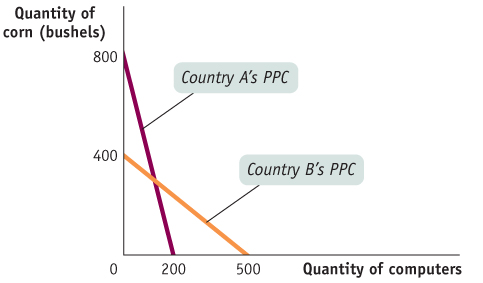Tackle the Test: Free-Response Questions
Question
Refer to the graph below to answer the following questions.

What is the opportunity cost of a bushel of corn in each country?
Which country has an absolute advantage in computer production? Explain.
Which country has a comparative advantage in corn production? Explain.
If each country specializes, what good will Country B import? Explain.
What is the minimum price Country A will accept to export corn to Country B? Explain.
Rubric for FRQ 1 (9 points)
1 point: Country A, ¼ computer; Country B, 1¼ computers
1 point: Country B
1 point: Because Country B can produce more computers than Country A (500 versus 200)
1 point: Country A
1 point: Because Country A can produce corn at a lower opportunity cost (¼ versus 1¼ computers)
1 point: Corn
1 point: Country B has a comparative advantage in the production of computers, so it will produce computers and import corn (Country A has a comparative advantage in corn production, so it will specialize in corn and import computers from Country B).
1 point: ¼ computer
1 point: Country A’s opportunity cost of producing corn is ¼ computer, so that is the lowest price it will accept to sell corn to Country B.
Question
Refer to the table below to answer the following questions. These two countries are producing textiles and wheat using equal amounts of resources.
Weekly output per worker Country A Country B Bushels of wheat 15 10 Units of textiles 60 60 What is the opportunity cost of producing a bushel of wheat for each country?
Which country has the absolute advantage in wheat production?
Which country has the comparative advantage in textile production? Explain. (5 points)
Rubric for FRQ 2 (5 points)
1 point: Country A: opportunity cost of 1 bushel ofwheat = 4 units of textiles.
1 point: 1 point: Country B: opportunity cost of 1 bushel of wheat = 6 units of textiles.
1 point: 1 point: Country A has an absolute advantage in the production of wheat. With the same resources, Country A can produce more bushels of wheat (15) than can Country B (10).
1 point: 1 point: Country B has the comparative advantage in textile production.
1 point: 1 point: Country B has a lower opportunity cost ofproducing textiles:
- Country A: opportunity cost of 1 unit of
- textiles = 1/4 bushel of wheat
- Country B: opportunity cost of 1 unit of
- textiles = 1/6 bushel of wheat
Alternate answer: Country B has the comparative advantage in the production of textiles because Country A has a comparative advantage in the production of wheat based on opportunity costs shown in part a.